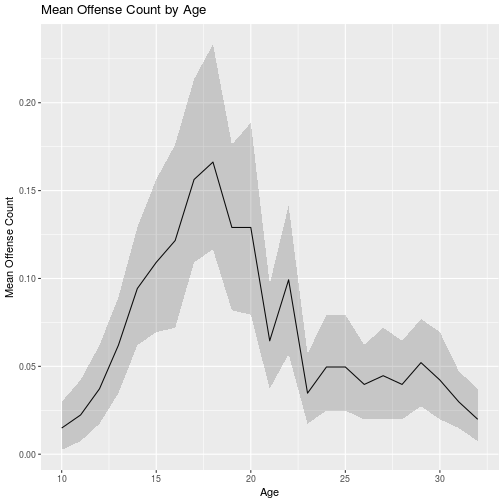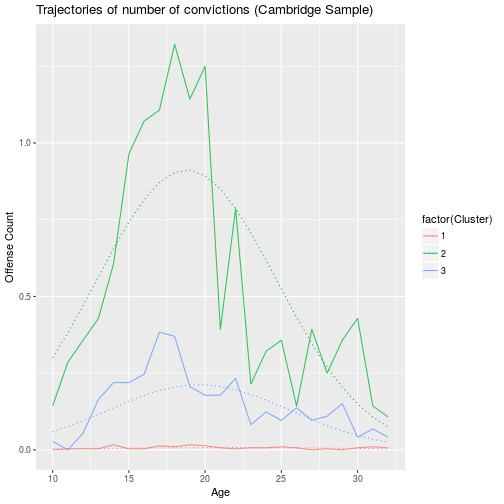Analyzing Developmental Trajectories
[unsupervised-learning R expectation-maximization clustering A developmental trajectory describes the course of a behavior over age or time.
Daniel Nagin pioneered a method
called Group-based Trajectory Modeling to cluster these trajectories into
groups. Link. This
method is quite popular in the medical and social sciences. In this post I will
take a look at his
paper
from 1999 - Analyzing Developmental Trajectories - A Semiparametric
Group-based approach and provide
some code in R to work through the datasets.
Datasets
There are two interesting datasets associated with this paper. The first is
from the Cambridge study of Delinquint Development. It tracked 411 British
males from a working area of London. Data collection began in the early 60s
when the boys were 8 years old and continued till they were around 32. It
included criminal convictions and measured variables related to a number of
factors including psychological makeup, family circumstances, parenting
behavior and performance in school/work. 
The second dataset is a study of 1037 White males of French ancestry. This also measures similar variables to the Cambridge study.
We shall mainly focus on the Cambridge study.
Cambridge Study
library(foreign)
# read in the data
cambridge <- read.dta("https://www.andrew.cmu.edu/user/bjones/traj/data/cambrdge.dta")This dataset has many columns and we can make some educated guesses about what is in them
- x01-x23 : Offense Counts (Number of offense counts in a year)
- x24-x46 : Unknown
- t1-t23 : Age
- tt1-tt23 : Scaled Age
- p1-p23 : Prevalence (Whether an offense was committed that year or not)
- y10 : ID
- other y’s : Unknown (Probably covariates)
We will mainly be working with the Offense Counts but first let’s convert this
dataset from wide to long. The dplyr toolset makes this easy.
library(dplyr)
library(tidyr)
library(readr)
# Convert Cambridge from wide to long format
# ID, TimeIdx (1-23), Age, Offense Count, Prevalence
# We drops the covariates and only keep the time series
cambridge_long <- cambridge %>%
rename(ID=y10) %>%
select(-starts_with("y")) %>% # drop covariates
select(-starts_with("tt")) %>% # drop scaled age
select(-(x24:x46)) %>% # drop unknown x variables
gather(variable, value, -ID) %>%
mutate(TimeIdx = parse_number(variable)) %>%
mutate(variable = gsub("\\d", "", x=variable)) %>%
spread(variable, value) %>%
select(ID, TimeIdx, Age=t, Prevalence=p, OffCount=x)
# A sampling of rows from the dataset
cambridge_long %>% slice(c(1:3, 20:23, 100:103, 7800:7804)) %>% print()## # A tibble: 16 x 5
## ID TimeIdx Age Prevalence OffCount
## <dbl> <dbl> <dbl> <dbl> <dbl>
## 1 1 1 10 0 0
## 2 1 2 11 0 0
## 3 1 3 12 0 0
## 4 1 20 29 0 0
## 5 1 21 30 0 0
## 6 1 22 31 0 0
## 7 1 23 32 0 0
## 8 5 8 17 0 0
## 9 5 9 18 0 0
## 10 5 10 19 1 1
## 11 5 11 20 1 1
## 12 347 3 12 0 0
## 13 347 4 13 1 3
## 14 347 5 14 1 2
## 15 347 6 15 0 0
## 16 347 7 16 1 2We look at the average number of offense counts by the boys ages and put some confidence intervals around the mean.
library(ggplot2)
ggplot(cambridge_long, aes(Age, OffCount)) +
stat_summary(fun.y="mean", geom="line") +
stat_summary(geom='ribbon', fun.data='mean_cl_boot', alpha=0.2) +
labs(title="Mean Offense Count by Age",
y= "Mean Offense Count")
It looks like males commit a lot of offenses in the mid/late teens compared to the other years.
Fitting a Group-Based Trajectory model
library(flexmix)
set.seed(1)
num_components <- 3
ages <- 10:32
m <- flexmix(OffCount ~ Age + I(Age^2) | ID, k=num_components,
model=FLXMRglm(family="poisson"),
data=cambridge_long)
m##
## Call:
## flexmix(formula = OffCount ~ Age + I(Age^2) | ID, data = cambridge_long,
## k = num_components, model = FLXMRglm(family = "poisson"))
##
## Cluster sizes:
## 1 2 3
## 6946 644 1679
##
## convergence after 86 iterationssummary(m)##
## Call:
## flexmix(formula = OffCount ~ Age + I(Age^2) | ID, data = cambridge_long,
## k = num_components, model = FLXMRglm(family = "poisson"))
##
## prior size post>0 ratio
## Comp.1 0.7104 6946 8073 0.860
## Comp.2 0.0676 644 2323 0.277
## Comp.3 0.2220 1679 9062 0.185
##
## 'log Lik.' -1909 (df=11)
## AIC: 3840 BIC: 3918cambridge_long$Cluster <- clusters(m)
GetAgeClusterPred <- function(age, k) {
p <- parameters(m, component=k)
exp(p[1] + p[2] * age + p[3] * age^2)
}
predictions <- expand.grid(Age=ages, Cluster=1:num_components) %>%
rowwise() %>% mutate(OffCount=GetAgeClusterPred(Age, Cluster) )ggplot(cambridge_long, aes(Age, OffCount, color=factor(Cluster))) +
stat_summary(fun.y=mean, geom="line", alpha=0.8) +
geom_line(data=predictions, aes(color=factor(Cluster)),
linetype="dotted") +
labs(y="Offense Count",
title="Trajectories of number of convictions (Cambridge Sample)")